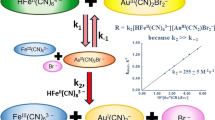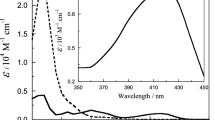Abstract
Oxidation of paracetamol by the Anderson-type hexamolybdocobaltate(III) anion [H6CoIIIMo6O24]3− was investigated at pH values of 1 and 2 in aqueous medium. The reaction is found to proceed through formation of a weak complex between the reactants. Under the reaction conditions, the oxidant exists in the [H5CoIIIMo5O20]2−, [H6CoIIIMo6O24]3− and dimeric \(\left[ {{\text{H}}_{4} {\text{Co}}_{2}^{{\rm III}} {\text{Mo}}_{10} {\text{O}}_{38} } \right]^{6-}\) forms, of which the first form is the most reactive. Inhibition of the reaction by the oxidant and also by molybdate ion suggests the existence of prior equilibria between various forms of the oxidant. The reaction involves direct electron transfer from neutral paracetamol to the anion, generating a free radical in the rate-determining step. The free radical undergoes further oxidation to N-acetyl-quinone imine as an intermediate, which then undergoes hydrolysis to give the final products p-benzoquinone and acetic acid. The ionic strength and solvent polarity had no significant effect on the rate of the reaction. A probable mechanism is proposed, leading to a complicated rate law as result of involvement of prior equilibria between various forms of the oxidant. The activation parameters were determined and are consistent with the proposed mechanism. The kinetic data were found to deviate from Marcus theory. This observation, together with the low and negative activation entropy, suggests the formation of a weak complex between the reactants.








Similar content being viewed by others
References
Nomiya K, Wada M, Murasaki H, Miwa M (1987) Synthesis of Co(III) molybdoheteropolyanions using carbonato-ammine Co(III) complexes as starting materials. Polyhedron 6:1343–1345
Barge JN, Gokavi GS (2016) Oxidation of hypophosphite and phosphite by anderson type hexamolybdocobaltate(III) anion. Int J Chem Kinet 48:106–113
Liu A, Wang K, Chen W, Gao F, Cai Y, Lin X, Chen Y, Xia X (2012) Simultaneous and sensitive voltammetric determination of acetaminophen and its degradation product for pharmaceutical quality control and pharmacokinetic research by using ultrathin poly (calconcarboxylic acid) film modified glassy carbon electrode. Electrochim Acta 63:161–168
Muir N, Nichols JD, Clifford JM, Sykes J (1997) Comparative bioavailability of aspirin and paracetamol following single dose administration of soluble and plain tablets. Curr Med Res Opin 13:491–500
Li J, Ye Q, Gan J (2004) Degradation and transformation products of acetaminophen in soil. Water Res 49:44–52
Krzysztof JR, Britigan LH, Rasmussen GT, Wagner BA, Burns P, Britigan BE (2004) Acetaminophen stimulates the peroxidative metabolism of anthracyclines. Arch Biochem Biophys 427:16–29
Brillas E, Sires I, Arias C, Cabot PL, Centellas F, Rodriguez RM, Garrido JA (2005) Mineralization of paracetamol in aqueous medium by anodic oxidation with a boron-doped diamond electrode. Chemosphere 58(4):399–406
Sires I, Garrido JA, Rodriguez RM, Cabot PL, Centellas F, Arias C, Brillas E (2006) Electrochemical degradation of paracetamol from water by catalytic action of Fe2+, Cu2+, and UVA light on electrogenerated hydrogen peroxide. J Electrochem Soc 153(1):1D–9D
Waterston KJW, Wang JWJ, Bejan D, Bunce NJ (2006) Electrochemical waste water treatment: electrooxidation of acetaminophen. J Appl Electrochem 36(2):227–232
Vogna D, Marotta R, Napolitano A, D’Ischia M (2002) Advanced oxidation chemistry of paracetamol. UV/H2O2-induced hydroxylation/degradation pathways and 15N-aided inventory of nitrogenous breakdown products. J Org Chem 67(17):6143–6151
Andreozzi R, Caprio V, Marotta R, Vogna D (2003) Paracetamol oxidation from aqueous solutions by means of ozonation. Water Res 37(5):993–1004
Skoumal M, Cabot PL, Centellas F, Arias C, Rodriguez RM, Garrido JA, Brillas (2006) Mineralization of paracetamol by ozonation catalyzed with Fe2+, Cu2+ and UVA light. Appl Catal 66(34):228–240
Yang LM, Yu LE, Ray MB (2008) Degradation of paracetamol in aqueous solutions by TiO2 photocatalysis. Water Res 42(13):3480–3488
Fischer V, West PR, Harman LS, Mason RP (1985) Free-radical metabolites of acetaminophen and a dimethylated derivative. Environ Health Perspect 64:127–137
Singh AK, Negi R, Jain B, Katre Y, Singh SP, Sharma VK (2011) Pd(II) catalyzed oxidative degradation of paracetamol by chloramine-T in acidic and alkaline media. Ind Eng Chem Res 50:8407–8419
Singh AK, Negi R, Jain B, Katre Y, Singh SP, Sharma VK (2009) Kinetics and mechanism of Ru(III)-catalyzed oxidation of paracetamol by chloramine-T in aqueous acidic medium. Catal Lett 132:285–291
Singh AK, Sen N, Chatterjee SK, Susan MABH (2016) kinetic study of oxidation of paracetamol by water-soluble MnO2 in presence of an anionic surfactant. Colloid Polym Sci 294:1611–1622
Baker LCW, McCutcheon TP (1956) Heteropoly salts containing Cobalt and hexavalent Tungsten in the Anion. J Am Chem Soc 78:4503–4510
Chou FM, Wang WT, Wei GT (2009) Using subcritical/supercritical fluid chromatography to separate acidic, basic and neutral compounds over an ionic liquid-functionalized stationary phase. J Chromatogr A 1216:3594–3599
Nolan AI, Burns RC, Lawrance GA (1996) Reaction kinetics and mechanism of formation of [H4Co2Mo10O38]6– by peroxomonosulfate oxidation of CoII in the presence of molybdate. J Chem Soc Dalton Trans. https://doi.org/10.1039/DT9960002629
Dahlin DC, Miwa GT, Lu AYH, Nelson SD (1984) N-acetyl-p-benzoquinoe imine: a cytochrome P-450-mediated oxidation product of acetaminophen. Proc Natl Acad Sci USA 81:1327–1331
Potter DW, Hinson JA (1987) The 1- and 2-electron oxidation of acetaminophen catalyzed by prostaglandin H synthase. J Biol Chem 262(3):974–980
Nematollahi D, Shayani-Jam H, Alimoradi M, Niroomand S (2009) Electrochemical oxidation of acetaminophen in aqueous solutions: kinetic evaluation of hydrolysis, hydroxylation and dimerization processes. Electrochim Acta 54:7407–7415
Marcus RA, Sutin N (1975) Electron-transfer reactions with unusual activation parameters. Treatement of reactions accompanied by large entropy decreases. Inorg Chem 14(1):213–216
Sami P, Mariselvi N, Venkateshwary K, Sarathi A, Rajasekharan K (2010) Studies on electron transfer reactions: reduction of heteropoly 10-tungstodivanadophosphate by thioglycolic acid in aqueous medium. J Chem Sci 122(3):335–340
Mehrotra M, Mehrotra RN (2003) The kinetics of the oxidation of thiourea by 12-tungstocobaltate(III) ion: evidence for anionic, neutral and protonated thiourea species in acetic acid–acetate buffer and perchloric acid solution. Dalton Trans 3606–3611
Author information
Authors and Affiliations
Corresponding author
Electronic supplementary material
Below is the link to the electronic supplementary material.
Rights and permissions
About this article
Cite this article
Sawant, J.D., Patil, K.K. & Gokavi, G.S. Kinetics and mechanism of oxidation of paracetamol by an Anderson-type 6-molybdocobaltate(III) in acidic medium. Transit Met Chem 44, 153–159 (2019). https://doi.org/10.1007/s11243-018-0279-4
Received:
Accepted:
Published:
Issue Date:
DOI: https://doi.org/10.1007/s11243-018-0279-4




